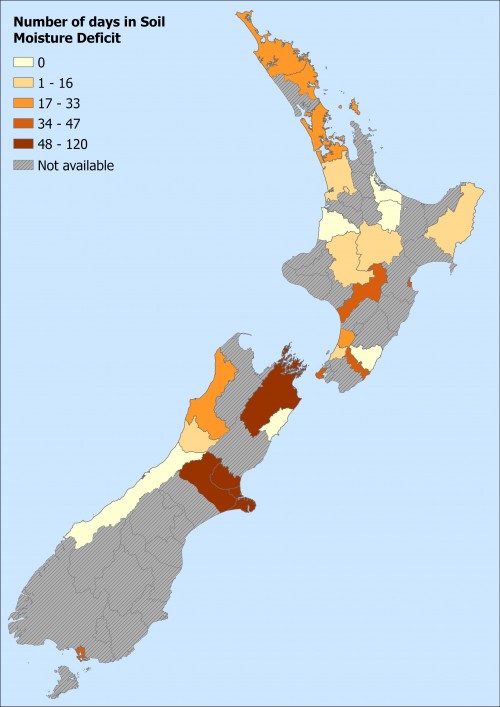Drought and rainfall
This section describes changes in drought conditions and extreme rainfall in Aotearoa New Zealand over time, and who might be most at risk of health impacts from these extremes.
On this page:
Climate models predict more droughts for parts of New Zealand
The amount of rainfall in New Zealand varies around the country and with season. It is projected that climate change will cause the annual amount of rainfall and the number of days with extreme rainfall to increase in the west and south and decrease in the north and east of both islands. The number of dry days is projected to increase in the North Island and in inland South Island [1].
Dry days more common in the east
Areas with more frequent dry periods are more likely to experience droughts, whereas areas with extreme rainfalls are more likely to experience flooding. Detecting changes in rainfall patterns in New Zealand is difficult due to the high variability in rainfall from year to year and from region to region. The variability is caused by changing weather patterns and natural climate variations such as El Niño [5].
Due largely to Cyclone Gabrielle and the extreme weather that led to the Auckland floods, much of the North Island received unusually high quantities of rainfall in 2023. Several TAs received 50% or more rainfall above their typical amount, and Gisborne received as much as 84% more rain than normal over the course of the year. (Figure 1).
Though data is limited, data for 2023 also suggests that Soil Moisture Deficit was most prevalent in the South Island (Figure 2).
Figure 1: Number of days with extreme rainfall, 2023, by Territorial Authority (TA)

Figure 2: Number of days with Soil Moisture Deficit, 2023, by Territorial Authority (TA)

Information about the data
Number of days with Soil Moisture Deficit
Source: CliFlo. NIWA's National Climate Database
Definition: Climate station data of the number of days per year in SMD from around New Zealand was sourced from the National Institute of Water and Atmospheric Research (NIWA). One climate station was selected per territorial authority, based on their proximity to the population-weighted centroid of each TA (2018 Census data). The number of dry days was counted for each year by TA. Only years with more than 90% of valid data were counted. Data was compared to the most recent Climate Normal Period, 1981-2010, where the 30-year average acts as a benchmark against which more recent observations can be compared to.
Annual amount of rainfall, and number of days with extreme rainfall
Source: CliFlo. NIWA's National Climate Database
Definition: Climate station data of the amount of daily rainfall (in mm) from around New Zealand was sourced from the National Institute of Water and Atmospheric Research (NIWA). One climate station was selected per territorial authority, based on their proximity to the population-weighted centroid of each TA (2018 Census data). The amount of rainfall was calculated for each year by TA. Only years with more than 90% of valid data were counted. The 95th percentile for the period 1981-2010 was calculated for each TA and number of days above this percentile was counted as extreme rainfall days. Data was compared to the most recent Climate Normal Period, 1981-2010, where the 30-year average acts as a benchmark against which more recent observations can be compared to.
